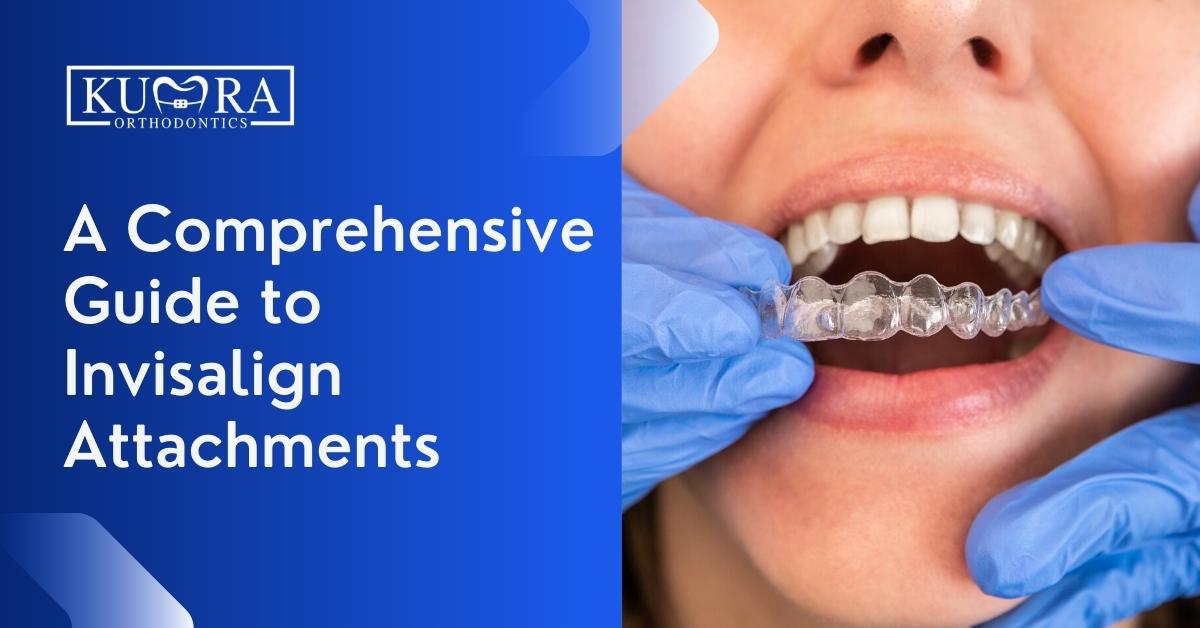Over the course of several weeks and months of treatment, Invisalign moves teeth as well as their roots. However, in some cases, the aligners cannot function independently.
Many adults and teenagers who want straight teeth but do not want to wear noticeable metal braces may find that Invisalign is an intriguing solution. With Invisalign, there are a few things to keep in mind, including the little-known Invisalign attachment.
Attachments for Invisalign make it possible for more patients to benefit from this groundbreaking orthodontic treatment, which also provides more predictable outcomes. However, what exactly are they and what function do they serve?
What are Invisalign Attachments?
Attachments are small dental pieces that are tooth-colored and are bonded to specific teeth as part of the treatment process for invisible braces. Because they serve as grips on which the Invisalign aligners may secure their hold, they are an extremely efficient means of shifting teeth. The attachments, which are also known as buttons, are designed to fit tightly over the aligners. This helps hold the aligners in place while they gradually and gently shift your teeth into their proper positions.
Attachments made with the proprietary technology known as SmartForce are designed to work exclusively with aligners made by Invisalign. The SmartForce attachments are available in a wide variety of forms and dimensions, and each one is tailored to a particular motion or hold on the object. The shape and size of the aligners that are used for the movement of each tooth will be determined by your Invisalign doctor.
Your Invisalign treatment will provide attractive, healthy, and long-lasting smiles when you use SmartForce attachments because they are made with premium materials and have innovative, cutting-edge designs that are designed to provide the most effective support possible.
How Invisalign Attachments Work?
Invisalign aligners are powerful. They move teeth and the roots of teeth over weeks and months of treatment. In some cases, the aligners do not work alone.
Little buttons known as attachments are sometimes a necessary part of Invisalign. They enable the aligners, which sometimes cannot accomplish alignment changes on their own because of the size, shape, or angle of a specific tooth, to move with a little extra force to shift teeth into their proper locations.
Needing an orthodontic appointment?
Visit Kumra Orthodontics Washington, DC or Kumra Orthodontics Stafford, VA, and request an appointment with us!
6 Things to Know About Invisalign Attachments
1. Adding attachments is a straightforward process
When you receive attachments for your Invisalign aligners, the orthodontist will bond a little piece of composite filling material to the middle of each of your teeth.
After preparing the surface of your teeth for bonding, your orthodontist will use an Invisalign template to indicate the sites of the attachments. Next, the bonding will be cured so that the tiny bump hardens and remains in its proper position. When the attachments are no longer needed, they will be rubbed off your tooth and removed from your mouth.
2. Sometimes attachments are visible
Attachments are placed on the surface of your teeth, just as the brackets that are used in traditional braces.
After the attachments are put on, many people are first apprehensive that other people would be able to see their aligners more clearly. Attachments may give the impression that they will increase the visibility of your aligners; however, the end consequence is that virtually no one will even notice that you are undergoing orthodontic treatment. During the time that you are using Invisalign, your orthodontist will color match your attachments to the color of your teeth so that they blend in seamlessly.
In point of fact, it’s possible that you’ll become more aware of your attachments while your aligners aren’t in your teeth. Consider this additional incentive to wear your trays as much as possible throughout the day!
3. Your attachments may be shaped differently
Attachments do not always have to take the shape of a circle. Depending on the method that your aligners use to shift your teeth into place, they might come in a variety of various forms and dimensions. Attachments that are square or triangle-shaped, for instance, might be of tremendous assistance in the treatment of common dental issues such as tooth rotation.
4. The position is planned carefully
Attachments are generally positioned in the center of the tooth, which anchors the aligner to make it perform very efficiently. Typically, precise inwards, outwards, or rotation movement demands an attachment in an off-center point.
5. Attachments are not necessary for every Invisalign patient
Even though attachments are fairly popular, it is not required for each and every Invisalign patient that has the treatment. Attachments are used with Invisalign to help achieve more complex tooth movement.
Although there is a wide range of orthodontic problems that can be fixed with Invisalign, there are still some problems that can only be fixed with traditional braces. As a result of attachments, an increasing number of people are able to straighten their teeth with Invisalign rather than having to deal with the nuisance of braces. However, even while attachments make Invisalign accessible to a larger population, this does not mean that every single Invisalign treatment will involve attachments. There is no reason to be concerned in the event that your orthodontic practitioner advises you to use attachments in order to finish your treatment with Invisalign. A smile that is more aligned requires only one additional action.
6. You need to watch out for plaques
Food particles can be trapped around attachments.
If you do not practice good dental hygiene, plaque can build up around the attachments, which can result in tooth decay. During treatment, you should make sure to clean your teeth at least twice per day to reduce the risk of bacteria and tooth decay.
Do Invisalign attachments hurt?
You may experience some pain when you first get attachments or when you switch to a new aligner. This is because of the pressure that your aligner places on your attachments, which helps reposition your teeth.
Also, when you remove your aligner, it’s possible that new attachments may feel uncomfortable against the inside of your mouth.
Any discomfort typically goes away over time. In the meantime, taking over-the-counter pain medications like acetaminophen (Tylenol) can help.
Read More: Invisalign Pain: What to Expect and How to Deal With It
Does everyone need attachments?
Not everyone with Invisalign needs attachments. Whether you’ll need them depends on your treatment plan.
Before your dentist begins the treatment, they’ll perform an examination. They may take photographs, X-rays, and impressions of your teeth to help design your aligners.
Depending on the type of tooth movement involved in the treatment, your dentist will determine whether you need attachments.
Read more: Is It Possible to Wear Invisalign When You’re Missing Teeth?
Consult with Kumra Orthodontics to learn more about Invisalign with attachments
If you are considering Invisalign treatment and have a complex dental situation, it is important to consult with an orthodontist about using attachments. Kumra Orthodontics can help you determine if Invisalign with attachments is the best option for your unique case. We offer a variety of attachments that can provide the additional movement needed to correct your smile. Contact us today to schedule a consultation and find out more about Invisalign with attachments!



